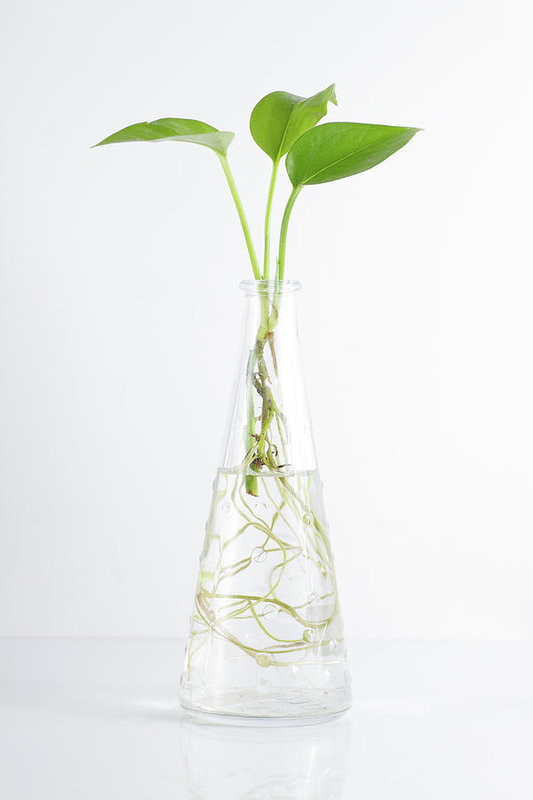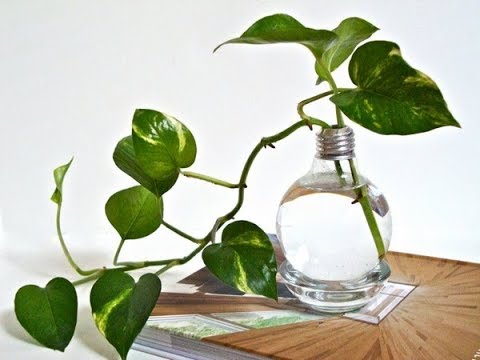Filtered or boiled water is good for money plant to ensure the removal of harmful chlorination, harmful bacteria and prevent the accumulation of minerals. Money plant, also known as devil’s ivy, is a popular indoor plant that can thrive in a wide range of environments.
This green, leafy plant is not only easy to grow but also considered to bring good luck and prosperity. However, to ensure the optimum growth of your money plant, you must be aware of its water requirements. The quality of the water affects the overall health and growth of the plant.
Using tap water directly can harm the plant due to the presence of chlorine and harmful minerals. Filtered or boiled water is suitable for money plant, which ensures the removal of harmful elements and provides a conducive environment for growth. Proper watering is essential to keep your money plant healthy and vibrant.

Credit: indiagardening.com
Understanding The Money Plant
Money plants are an excellent addition to any household. With their bright green foliage and reputation for bringing good fortune, it’s no surprise that many people want to grow these plants. However, when it comes to watering the money plant, things can be a bit tricky.
In this blog post, we’ll delve into which water is good for the money plant and share some information on understanding and growing this plant.
Introduction To The Money Plant’S Color, Leaves, And Factors That Result In Slow Growth
Money plants are commonly known as golden pothos, devil’s ivy, or silver vine. They’re mostly grown for their beautiful greenery, which can brighten any room. This plant comes in different colors, including green, yellow, and white, with heart-shaped leaves.
Factors, such as insufficient light, water, or nutrients, can result in slow growth and affect the vivid color of the plant. Leaves may become discolored, wilt, or end up falling off. Moreover, pests and diseases can lead to such issues.
It’s essential to understand the factors that may impact the growth of the money plant and take necessary steps to avoid them.
Here’s a list of key points to help you understand how to grow and maintain your money plant:
- Keep the soil moist but not soggy, as the roots may rot, which can result in slow growth.
- Install a bamboo stake, moss stick, or wires to hang or support the money plant for it to grow and look good.
- Ensure sufficient light and temperature, keep them out of direct sunlight, cold drafts, and air conditioning units’ path.
- Fertilize regularly with a balanced fertilizer to keep the plant healthy.
How To Avoid/Manage Common Pests And Diseases That Infect Money Plant
Even with all the care and attention in the world, pests and diseases can attack the money plant. Here are the most common pests and diseases to watch out for:
- Spider mites: These tiny pests can infest money plants and other indoor plants. They appear as tiny spots, mostly on the underside of leaves. Use a neem oil or an insecticidal soap to keep them under control.
- Mealybugs: These white, cotton-like pests can appear on leaves and stems. They suck the sap from the plant and can cause stunted growth. Use rubbing alcohol or an insecticidal soap to remove them.
- Root rot: If the plant is overwatered, it can lead to root rot, yellowing, and falling off of the leaves. It can be prevented by allowing the soil to dry out between watering, applying a fungicide and keeping the plant away from drafts.
The key to avoiding pest infestations and fungal diseases is to keep the plant healthy and free from stress. Water appropriately, provide sufficient light, and keep the environment clean, including pruning the plant regularly.
With the right care and attention, money plants can brighten up any indoor space. Ensure they receive appropriate watering and light, install support structures to help them grow, and watch for pests and diseases to keep them healthy and vibrant.
Types Of Water For Money Plant
Money plant, also known as jade plant, is a popular indoor plant that not only adds to the aesthetic appeal of a room but also has been known to bring good financial luck. To ensure that your money plant thrives and flourishes, it is vital to understand which type of water is suitable for its growth and development.
In this blog post, we will explore the different types of water and their benefits and limitations when it comes to nurturing your money plant.
Tap Water:
Tap water is the most readily available and utilized source of water for money plants. However, it contains minerals that can negatively impact your plant’s growth. Here are the key points to consider when it comes to using tap water:
- Tap water contains a high level of chlorine that can help to maintain healthy roots and protect the plant from pests and diseases.
- However, excessive chlorine can also harm the soil’s organic matter and hinder the growth of beneficial microbes.
- The minerals present in tap water, such as fluoride, chlorine, and calcium, can accumulate in the soil and adversely affect the quality of the soil and the plant’s growth.
Filtered Water:
Filtered water is another viable option when it comes to watering your money plant. The process of filtration removes the contaminants and minerals present in tap water, making it healthier for the plant to thrive. Here are the key points to consider:
- Filtered water is free from contaminants such as lead, copper, and other minerals that can harm your plant.
- It helps to protect the plant from mineral build-up that can cause the soil to become compacted and affect the plant’s root system.
- This type of water is suitable for indoor plants as it is less acidic as compared to tap water.
Boiled Water:
Boiling water is another option for providing water to your money plant. The process of boiling removes impurities and makes the water safer for use. Here are the benefits and disadvantages of using boiled water for your plant:
- Boiling water kills bacteria, viruses, and other harmful microorganisms present in the water that can cause damage to the plant or the soil.
- It also helps to soften the water, reducing the harmful effects of minerals in the water.
- However, boiled water can negatively impact the ph level of the soil and harm beneficial bacteria and fungi in the soil b this can reduce the overall health of the soil and affect the plant’s growth.
Rainwater:
Rainwater is one of the purest sources of water for your money plant, and it is naturally rich in essential nutrients that promote your plant’s growth. Below are the benefits of harvesting rainwater:
- Rainwater is free of contaminants and minerals that can cause harm to your plant’s soil and root system, making it a healthier and more natural choice for watering your plant.
- Rainwater helps to maintain the soil’s acidity level, which is essential for optimal plant growth and development.
- Harvesting rainwater is a cost-effective way of providing water to your plant, and it is also an eco-friendly approach to gardening.
Distilled Water:
Distilled water is another option when it comes to watering your money plant. It is produced by the process of distillation and is free of any minerals and contaminants that can harm your plant’s health. Here are the benefits and limitations of using distilled water:
- Distilled water is free of any dissolved substances such as minerals, bacteria, and viruses, making it the purest form of water available for your plant.
- It is a safe option for plants that are sensitive to mineral build-up, such as african violets, peace lilies, and money plants.
- However, it lacks the essential nutrients that are present in tap water and rainwater, which are crucial for promoting plant growth and development.
The right type of water can make a world of difference in ensuring your money plant’s health and vitality. Whether you choose tap water, filtered water, boiled water, rainwater, or distilled water, make sure that you understand the benefits and limitations of each and use them accordingly to promote optimal plant growth and health.
Best Practices For Watering Money Plant
Money plant is one of the easiest indoor plants to care for. It has decorative foliage and brings natural elements indoors. These plants are capable of growing under different lighting conditions and don’t need too much care. However, to keep them healthy and thriving, watering them is crucial.
In this blog post, we will cover the best practices for watering money plant with the subheading: best practices for watering money plant.
Frequency
Money plants do not require frequent watering like most other indoor plants. They are drought-tolerant and can survive for a few days without water. Overwatering can lead to root rot, so keep the soil moist but not soggy. Water the plant once a week or when the soil feels dry to the touch.
The best time to water the plant is early in the morning or late in the evening.
Watering Techniques
Different watering techniques can be used for money plants. Some of the techniques include drenching, watering with a spray bottle, and sub-irrigation. Here is a brief explanation of these techniques.
- Drenching: Pour water into the soil until it drains out of the drainage holes. Discard excess water.
- Watering with a spray bottle: Spray water on the soil until it is moist. Be careful not to wet the leaves as it can cause fungal diseases.
- Sub-irrigation: Place the plant in a container filled with water. The water will be absorbed through the drainage holes in the pot.
Overwatering And Underwatering
Overwatering and underwatering can lead to the death of the plant. Signs of overwatering include yellowing and wilted leaves, a foul smell from the soil, and brown and mushy roots. If you notice these signs, reduce watering and improve drainage.
Signs of underwatering include curling and crispy leaves, dry soil, and stunted growth. If you spot these symptoms, increase watering and ensure the soil is moist.
Watering money plants is crucial for their growth and survival. Water the plants once a week or when the soil feels dry. Use different watering techniques like drenching, spraying, or sub-irrigation. Be wary of overwatering and underwatering and watch for signs that indicate these conditions.
With these best practices, your money plant will thrive and keep your indoor space adorned with beautiful greenery.
Factors That Affect Watering Needs Of Money Plant
Money plant (epipremnum aureum) is a popular plant for indoor gardening enthusiasts due to its beautiful appearance, air-purifying qualities, and low maintenance requirements. Watering is the most crucial factor in keeping the money plant healthy and thriving. In this section of the blog post, we will discuss the factors that affect the watering needs of money plant, including humidity, heat, and seasonal changes.
Humidity:
Humidity plays an essential role in the growth and watering needs of the money plant. High humidity levels reduce the watering needs of the plant, while low humidity levels increase the watering needs. Here are some key points regarding the correlation between humidity levels and the watering needs of the money plant:
- Keep the money plant in a location with high humidity levels to reduce the watering needs.
- Low humidity levels will make the plant wilt, causing an increase in watering requirements.
- Use a humidifier or place a water-filled tray near the plant to maintain the required humidity levels.
Heat:
Heat is another factor that significantly impacts the watering needs of money plant. High temperatures increase the water requirements, while cooler temperatures decrease the watering needs of the plant. Here are some key points regarding the impact of heat on the watering needs of the money plant:
- Increase watering frequency during hot and dry weather conditions.
- Reduce watering frequency during cooler weather conditions.
- Avoid placing the plant near heating or air conditioning systems and keep it away from direct sunlight.
Seasonal Changes:
The watering needs of the money plant also change according to the season. During the growing season (spring and summer), the plant requires more water than during the dormancy period (fall and winter). Here are some key points regarding changes in watering requirements of the money plant as per the season:
- In spring and summer, the money plant requires frequent watering to keep the soil slightly moist.
- Reduce the frequency of watering in the fall and winter and let the soil dry out partially between watering.
- Be mindful not to overwater the plant during the dormant period, as it may cause root rot.
Understanding the factors affecting the watering needs of the money plant is crucial to keep it healthy and thriving. Keep in mind the correlation between humidity levels and watering needs, the impact of heat on watering requirements, and the changes in watering requirements according to seasonal changes.
By following these tips, you can ensure your money plant will continue to thrive for years to come!
Tips For General Money Plant Care
Money plants have been a popular choice among plant enthusiasts all around the world. Not only do they add a hint of green but also aid in enhancing the interior’s appeal and are known to bring good fortune. There are a few things to consider when it comes to the general care of money plants.
Here are some tips for general money plant care.
Soil Type And Ph
The right soil type and ph are essential to ensure the money plant’s growth and development. Here are a few key points to keep in mind:
- Money plants grow well in a well-draining soil mixture consisting of peat, perlite, and sand.
- A neutral to slightly acidic soil with a ph of 6.0 to 7.5 is ideal for their growth.
- Proper soil aeration is crucial for their healthy growth, and henceforth you must ensure the soil’s quality is light and porous.
- Make sure to avoid over-watering the money plants, as it can cause root rot and affect the soil’s ph.
Light Requirements
Money plants require proper light to flourish and grow. Here is what you need to keep in mind:
- Money plants thrive in bright, indirect sunlight.
- Make sure to keep them away from direct sunlight as it can scorch their delicate foliage.
- While artificial lights can also support their growth, it is best to keep them in a bright but shaded position inside your home.
Fertilization
Fertilization is essential for the money plant’s growth and development. Here are some points to keep in mind:
- You can feed your money plant every two to four weeks during the growing season, i.e., late spring to early autumn.
- It is recommended to use a balanced water-soluble fertilizer, diluted in half strength with water.
- Always water the plant thoroughly after applying the fertilizer to avoid root burn.
Propagation
Propagation is necessary to expand your collection of money plants. Here are some methods you can adopt:
- Money plants can be propagated using stem cuttings, which require at least two nodes.
- Vine cuttings with aerial roots, when planted in the soil, start to grow as an independent plant.
- Artificial propagation using seeds can also be done, which have a high success rate.
Keep these tips in mind, and your money plants will thrive beautifully, enhancing the aesthetic appeal of your surroundings, and adding positivity into your life.
Frequently Asked Questions Of Which Water Is Good For Money Plant
What Type Of Water Is Best For Money Plants?
The best type of water for money plants is filtered or distilled water. Tap water can contain chemicals and minerals that can damage the plant’s leaves.
How Often Should You Water A Money Plant?
Money plants should be watered once a week. Wait until the soil is slightly dry before watering and make sure not to over water as it can cause root rot.
Can You Use Tap Water For Money Plants?
Tap water can be used for money plants, but it’s better to let it sit out for 24 hours to allow the chlorine to evaporate. Alternatively, using filtered or distilled water is recommended.
How Much Sunlight Does A Money Plant Need?
Money plants prefer indirect sunlight or partial shade. It’s best to place them in a location where they can get a few hours of sunlight a day, but avoid direct sunlight that can damage the leaves.
How Can You Tell If A Money Plant Needs More Water?
You can tell if a money plant needs more water if its leaves start to droop or if the soil is dry to the touch. It’s important to not over water and to allow the soil to slightly dry out between waterings.
Conclusion
As we wrap up our discussion on the best water for money plant watering, it is essential to note that water quality matters. By providing your money plant with clean, filtered water, you will prevent the accumulation of minerals and toxins that could damage your plant.
Depending on your location, the source of water you use will vary, and it is crucial to understand its content before using it on your plants. However, if you’re still unsure about the water quality, you can use distilled or rainwater, which may require a little more effort but are safer options.
Remember that while water is essential for plant growth, overwatering can also be detrimental. Always observe the soil and avoid letting the soil dry out or become too soggy. By following these tips and using the best water for your money plant, you can ensure its longevity and beauty in your home or garden.




